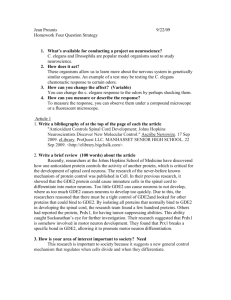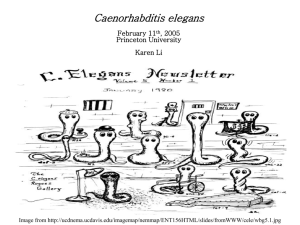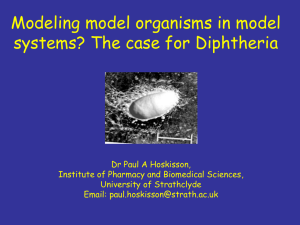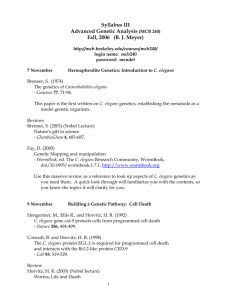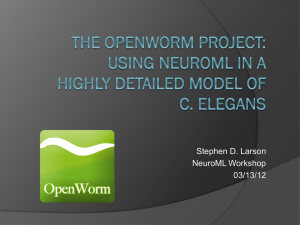quack7introhw5
advertisement
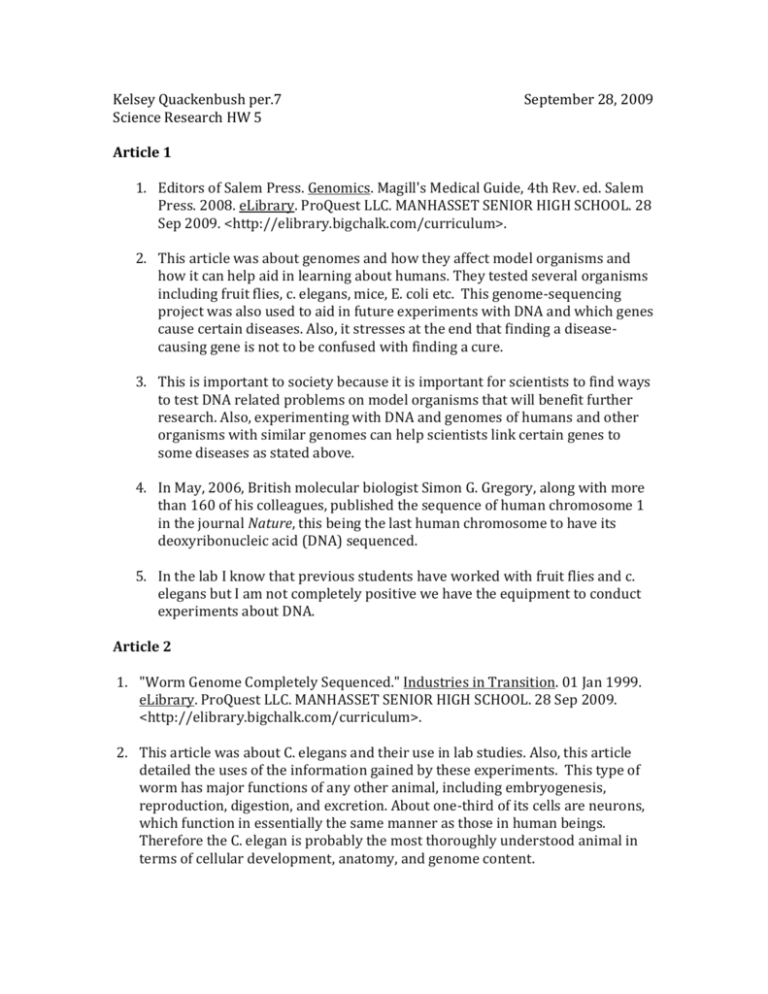
Kelsey Quackenbush per.7 Science Research HW 5 September 28, 2009 Article 1 1. Editors of Salem Press. Genomics. Magill's Medical Guide, 4th Rev. ed. Salem Press. 2008. eLibrary. ProQuest LLC. MANHASSET SENIOR HIGH SCHOOL. 28 Sep 2009. <http://elibrary.bigchalk.com/curriculum>. 2. This article was about genomes and how they affect model organisms and how it can help aid in learning about humans. They tested several organisms including fruit flies, c. elegans, mice, E. coli etc. This genome-sequencing project was also used to aid in future experiments with DNA and which genes cause certain diseases. Also, it stresses at the end that finding a diseasecausing gene is not to be confused with finding a cure. 3. This is important to society because it is important for scientists to find ways to test DNA related problems on model organisms that will benefit further research. Also, experimenting with DNA and genomes of humans and other organisms with similar genomes can help scientists link certain genes to some diseases as stated above. 4. In May, 2006, British molecular biologist Simon G. Gregory, along with more than 160 of his colleagues, published the sequence of human chromosome 1 in the journal Nature, this being the last human chromosome to have its deoxyribonucleic acid (DNA) sequenced. 5. In the lab I know that previous students have worked with fruit flies and c. elegans but I am not completely positive we have the equipment to conduct experiments about DNA. Article 2 1. "Worm Genome Completely Sequenced." Industries in Transition. 01 Jan 1999. eLibrary. ProQuest LLC. MANHASSET SENIOR HIGH SCHOOL. 28 Sep 2009. <http://elibrary.bigchalk.com/curriculum>. 2. This article was about C. elegans and their use in lab studies. Also, this article detailed the uses of the information gained by these experiments. This type of worm has major functions of any other animal, including embryogenesis, reproduction, digestion, and excretion. About one-third of its cells are neurons, which function in essentially the same manner as those in human beings. Therefore the C. elegan is probably the most thoroughly understood animal in terms of cellular development, anatomy, and genome content. 3. This article is important to society because of the breakthroughs in science it can foretell. For instance, "Half of the disease genes in humans have identifiable counterparts in this worm," says Francis Collins, director of the National Human Genome Research Institute. Some proteins involved in Alzheimer's disease, for instance, were originally identified by analogy to worm proteins. Also, Axys Pharmaceuticals is among the companies that use the worm as a model system to promote human drug discovery. 4. The sequence project was directed by Robert H. Waterston, a professor at Washington University Medical School, in collaboration with researchers at the Sanger Center of the Medical Research Council in Cambridge, U.K. 5. Previous studies at Manhasset High School have been done using C. elegans. Article 3 1. Travis, John. "Worm offers the first animal genome." Science News. 12 Dec 1998. 372. eLibrary. ProQuest LLC. MANHASSET SENIOR HIGH SCHOOL. 28 Sep 2009. <http://elibrary.bigchalk.com/curriculum>. 2. This article is about C. elegans and their genomes, and the affect this has on our society. In the journal, investigators announce that they have essentially finished sequencing the worm's genome, making it the first multicellular organism whose full set of genes is known. Gary Ruvkun of the Massachusetts General Hospital in Boston says "The worm genome, being the first animal genome, becomes the brightest lighthouse for the navigation of all animal genomics." Also, compared with viruses, bacteria, or yeast-the other organisms whose genomes have been sequenced-the microscopic C elegans much more closely resembles complex animals, including people. 3. This is important to society because it can affect treatments for certain diseases and also agriculture. Waterson says "Because C. elegans has so many genes shared with humans . . . we can figure out what they're doing in C elegans and apply that to a whole myriad of human genetic issues," says Waterston. Also, Scientists also hope that knowledge of the C elegans genome will help people deal with worms that cause human illnesses and agricultural problems. 4. The sequencing of C elegans DNA, led by scientists at the Sanger Centre in Cambridge, England, and the Washington University School of Medicine in St. Louis, began about 8 years ago. 5. C. elegans have been previously used in students experiments.



